Economic Growth and Saudi Arabia
VerifiedAdded on 2020/05/28
|17
|3217
|135
AI Summary
This assignment analyzes the factors influencing economic growth in Saudi Arabia. It examines the role of foreign direct investment (FDI), government spending, inflation, interest rates, and unemployment. The analysis draws upon research papers and economic data from sources like Trading Economics to understand the complex interplay between these variables and their impact on Saudi Arabia's economic performance.
Contribute Materials
Your contribution can guide someone’s learning journey. Share your
documents today.
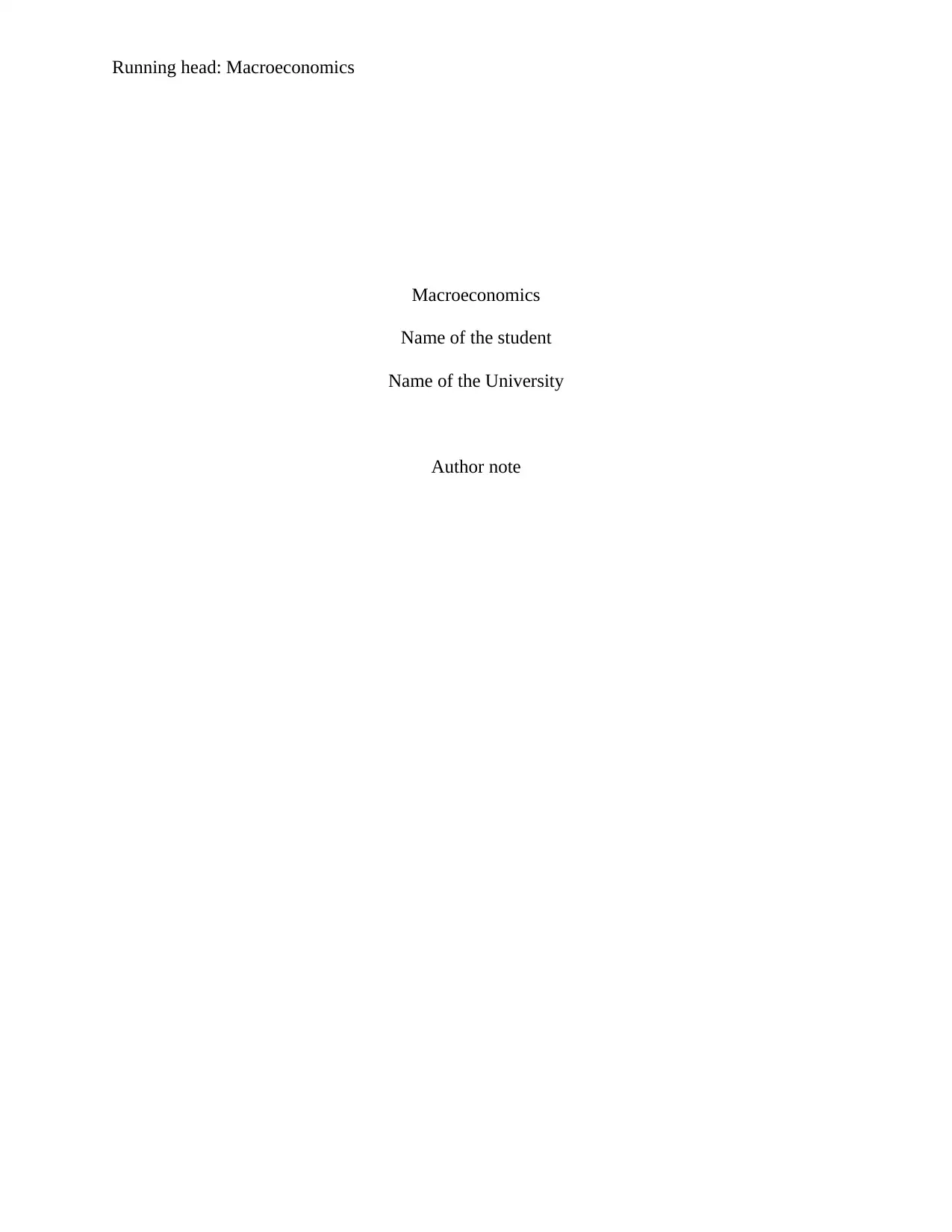
Running head: Macroeconomics
Macroeconomics
Name of the student
Name of the University
Author note
Macroeconomics
Name of the student
Name of the University
Author note
Secure Best Marks with AI Grader
Need help grading? Try our AI Grader for instant feedback on your assignments.
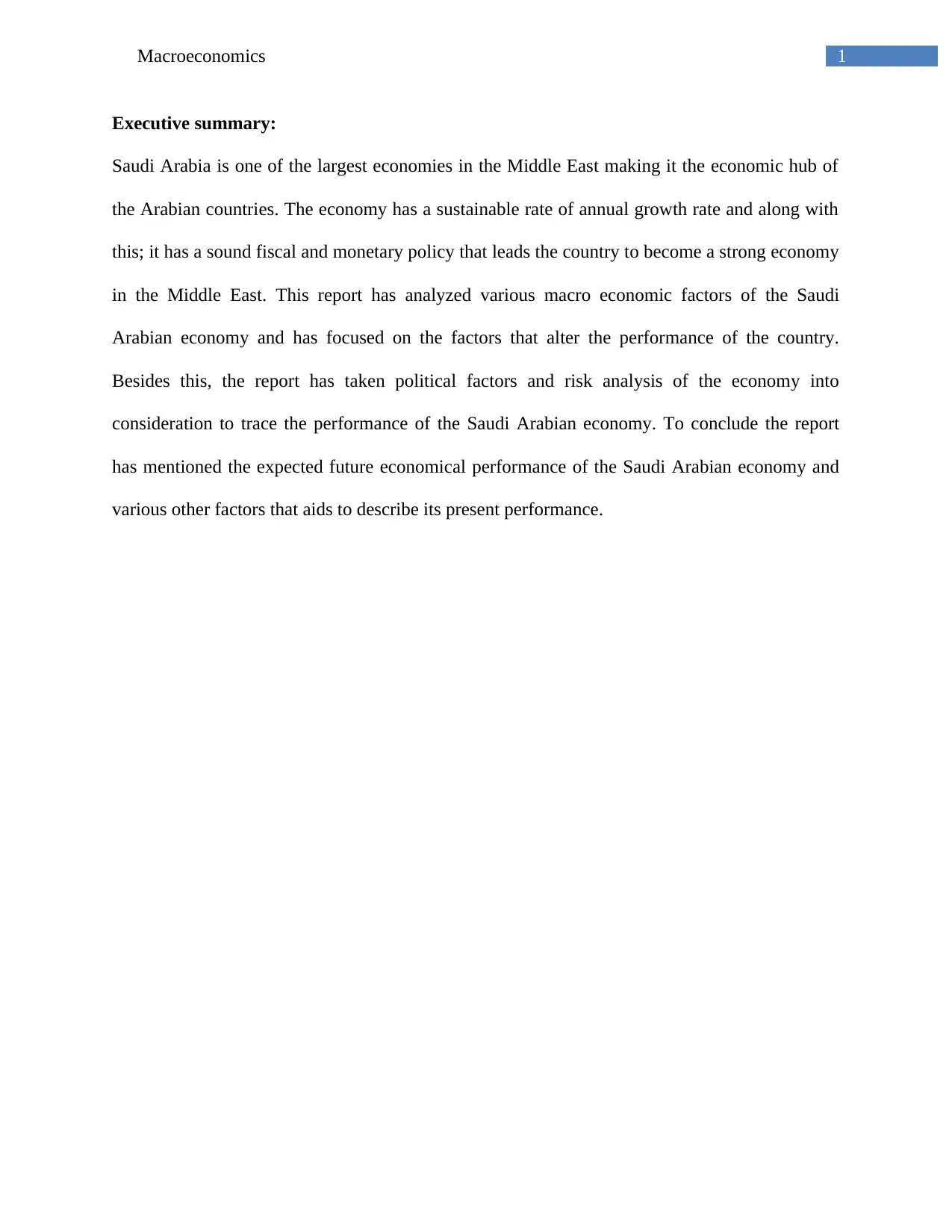
1Macroeconomics
Executive summary:
Saudi Arabia is one of the largest economies in the Middle East making it the economic hub of
the Arabian countries. The economy has a sustainable rate of annual growth rate and along with
this; it has a sound fiscal and monetary policy that leads the country to become a strong economy
in the Middle East. This report has analyzed various macro economic factors of the Saudi
Arabian economy and has focused on the factors that alter the performance of the country.
Besides this, the report has taken political factors and risk analysis of the economy into
consideration to trace the performance of the Saudi Arabian economy. To conclude the report
has mentioned the expected future economical performance of the Saudi Arabian economy and
various other factors that aids to describe its present performance.
Executive summary:
Saudi Arabia is one of the largest economies in the Middle East making it the economic hub of
the Arabian countries. The economy has a sustainable rate of annual growth rate and along with
this; it has a sound fiscal and monetary policy that leads the country to become a strong economy
in the Middle East. This report has analyzed various macro economic factors of the Saudi
Arabian economy and has focused on the factors that alter the performance of the country.
Besides this, the report has taken political factors and risk analysis of the economy into
consideration to trace the performance of the Saudi Arabian economy. To conclude the report
has mentioned the expected future economical performance of the Saudi Arabian economy and
various other factors that aids to describe its present performance.
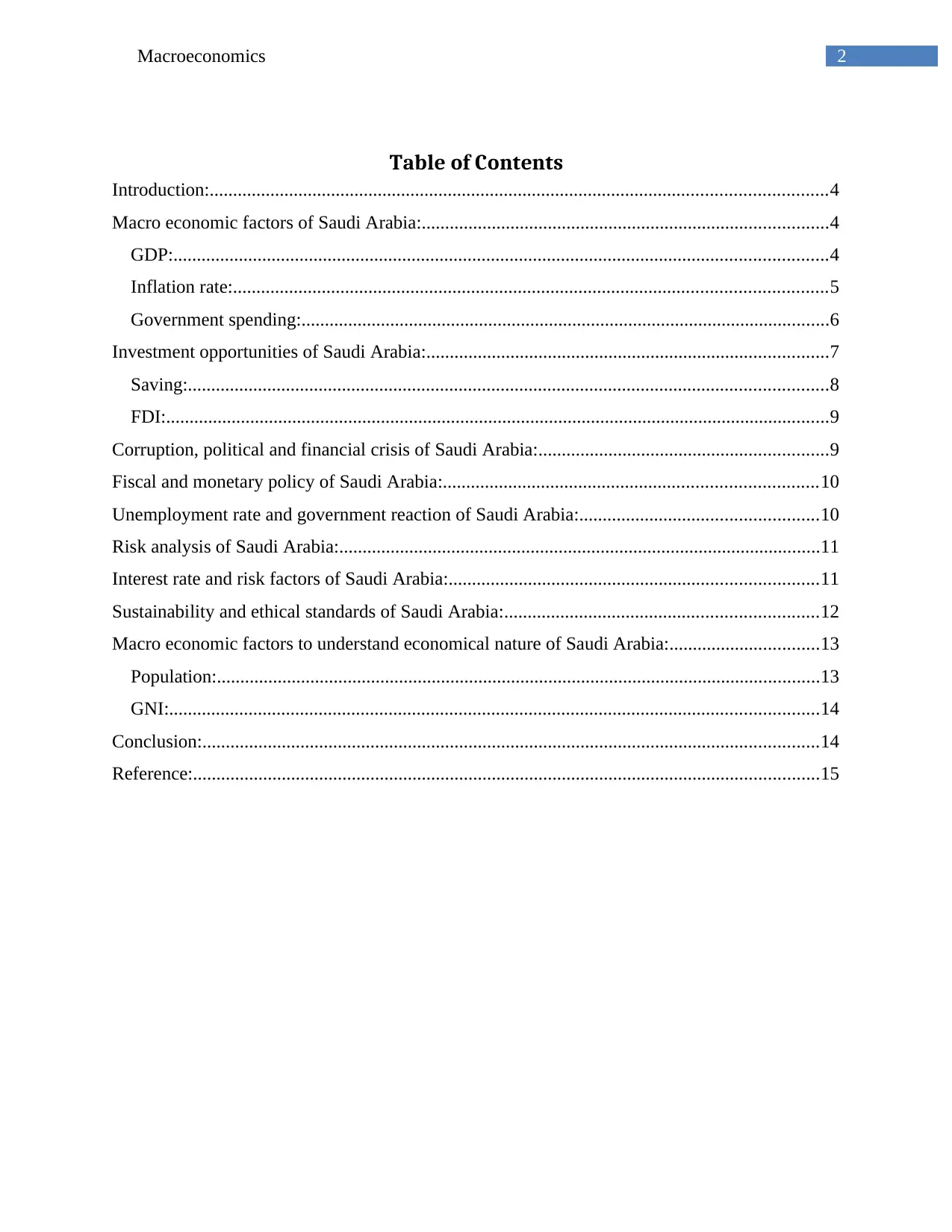
2Macroeconomics
Table of Contents
Introduction:....................................................................................................................................4
Macro economic factors of Saudi Arabia:.......................................................................................4
GDP:............................................................................................................................................4
Inflation rate:...............................................................................................................................5
Government spending:.................................................................................................................6
Investment opportunities of Saudi Arabia:......................................................................................7
Saving:.........................................................................................................................................8
FDI:..............................................................................................................................................9
Corruption, political and financial crisis of Saudi Arabia:..............................................................9
Fiscal and monetary policy of Saudi Arabia:................................................................................10
Unemployment rate and government reaction of Saudi Arabia:...................................................10
Risk analysis of Saudi Arabia:.......................................................................................................11
Interest rate and risk factors of Saudi Arabia:...............................................................................11
Sustainability and ethical standards of Saudi Arabia:...................................................................12
Macro economic factors to understand economical nature of Saudi Arabia:................................13
Population:.................................................................................................................................13
GNI:...........................................................................................................................................14
Conclusion:....................................................................................................................................14
Reference:......................................................................................................................................15
Table of Contents
Introduction:....................................................................................................................................4
Macro economic factors of Saudi Arabia:.......................................................................................4
GDP:............................................................................................................................................4
Inflation rate:...............................................................................................................................5
Government spending:.................................................................................................................6
Investment opportunities of Saudi Arabia:......................................................................................7
Saving:.........................................................................................................................................8
FDI:..............................................................................................................................................9
Corruption, political and financial crisis of Saudi Arabia:..............................................................9
Fiscal and monetary policy of Saudi Arabia:................................................................................10
Unemployment rate and government reaction of Saudi Arabia:...................................................10
Risk analysis of Saudi Arabia:.......................................................................................................11
Interest rate and risk factors of Saudi Arabia:...............................................................................11
Sustainability and ethical standards of Saudi Arabia:...................................................................12
Macro economic factors to understand economical nature of Saudi Arabia:................................13
Population:.................................................................................................................................13
GNI:...........................................................................................................................................14
Conclusion:....................................................................................................................................14
Reference:......................................................................................................................................15
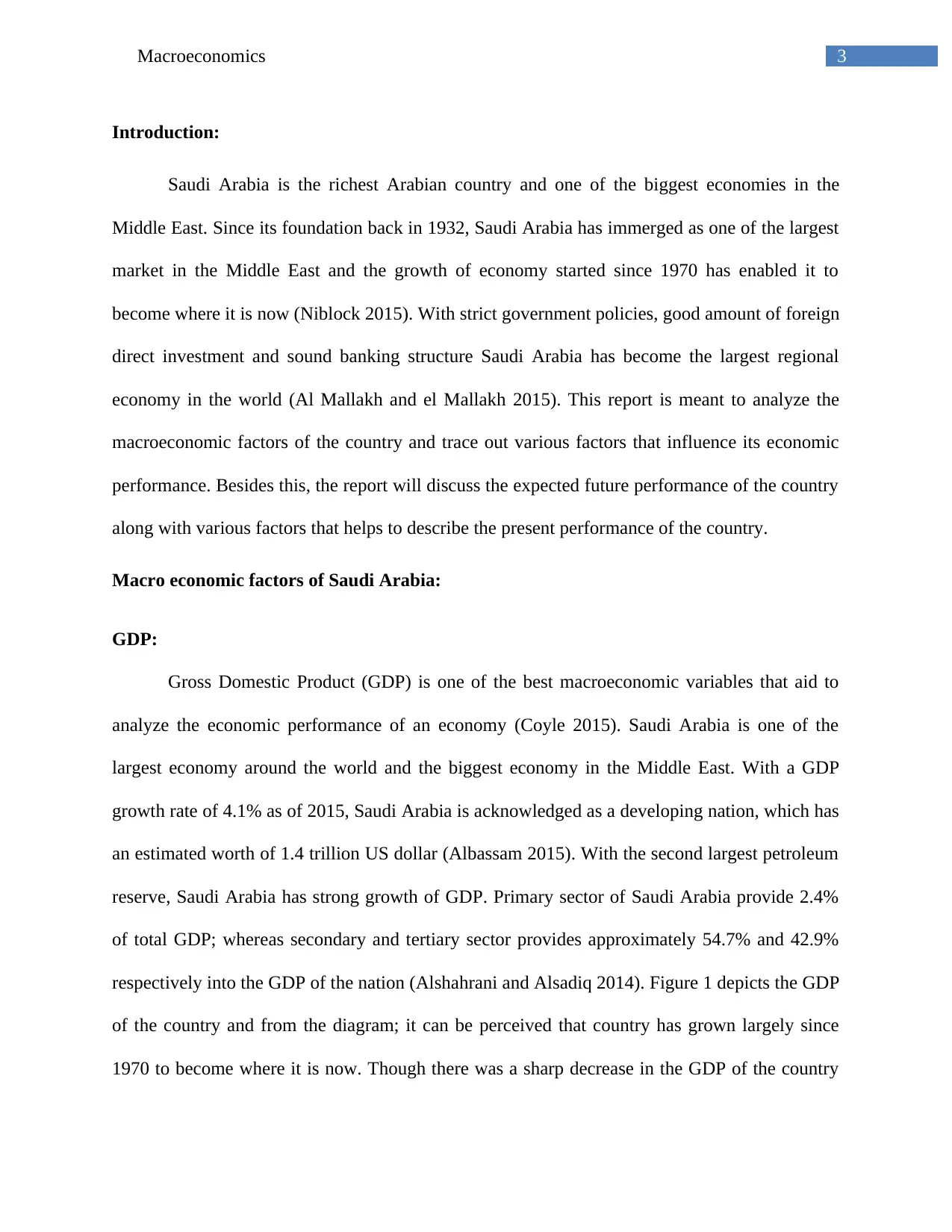
3Macroeconomics
Introduction:
Saudi Arabia is the richest Arabian country and one of the biggest economies in the
Middle East. Since its foundation back in 1932, Saudi Arabia has immerged as one of the largest
market in the Middle East and the growth of economy started since 1970 has enabled it to
become where it is now (Niblock 2015). With strict government policies, good amount of foreign
direct investment and sound banking structure Saudi Arabia has become the largest regional
economy in the world (Al Mallakh and el Mallakh 2015). This report is meant to analyze the
macroeconomic factors of the country and trace out various factors that influence its economic
performance. Besides this, the report will discuss the expected future performance of the country
along with various factors that helps to describe the present performance of the country.
Macro economic factors of Saudi Arabia:
GDP:
Gross Domestic Product (GDP) is one of the best macroeconomic variables that aid to
analyze the economic performance of an economy (Coyle 2015). Saudi Arabia is one of the
largest economy around the world and the biggest economy in the Middle East. With a GDP
growth rate of 4.1% as of 2015, Saudi Arabia is acknowledged as a developing nation, which has
an estimated worth of 1.4 trillion US dollar (Albassam 2015). With the second largest petroleum
reserve, Saudi Arabia has strong growth of GDP. Primary sector of Saudi Arabia provide 2.4%
of total GDP; whereas secondary and tertiary sector provides approximately 54.7% and 42.9%
respectively into the GDP of the nation (Alshahrani and Alsadiq 2014). Figure 1 depicts the GDP
of the country and from the diagram; it can be perceived that country has grown largely since
1970 to become where it is now. Though there was a sharp decrease in the GDP of the country
Introduction:
Saudi Arabia is the richest Arabian country and one of the biggest economies in the
Middle East. Since its foundation back in 1932, Saudi Arabia has immerged as one of the largest
market in the Middle East and the growth of economy started since 1970 has enabled it to
become where it is now (Niblock 2015). With strict government policies, good amount of foreign
direct investment and sound banking structure Saudi Arabia has become the largest regional
economy in the world (Al Mallakh and el Mallakh 2015). This report is meant to analyze the
macroeconomic factors of the country and trace out various factors that influence its economic
performance. Besides this, the report will discuss the expected future performance of the country
along with various factors that helps to describe the present performance of the country.
Macro economic factors of Saudi Arabia:
GDP:
Gross Domestic Product (GDP) is one of the best macroeconomic variables that aid to
analyze the economic performance of an economy (Coyle 2015). Saudi Arabia is one of the
largest economy around the world and the biggest economy in the Middle East. With a GDP
growth rate of 4.1% as of 2015, Saudi Arabia is acknowledged as a developing nation, which has
an estimated worth of 1.4 trillion US dollar (Albassam 2015). With the second largest petroleum
reserve, Saudi Arabia has strong growth of GDP. Primary sector of Saudi Arabia provide 2.4%
of total GDP; whereas secondary and tertiary sector provides approximately 54.7% and 42.9%
respectively into the GDP of the nation (Alshahrani and Alsadiq 2014). Figure 1 depicts the GDP
of the country and from the diagram; it can be perceived that country has grown largely since
1970 to become where it is now. Though there was a sharp decrease in the GDP of the country
Secure Best Marks with AI Grader
Need help grading? Try our AI Grader for instant feedback on your assignments.
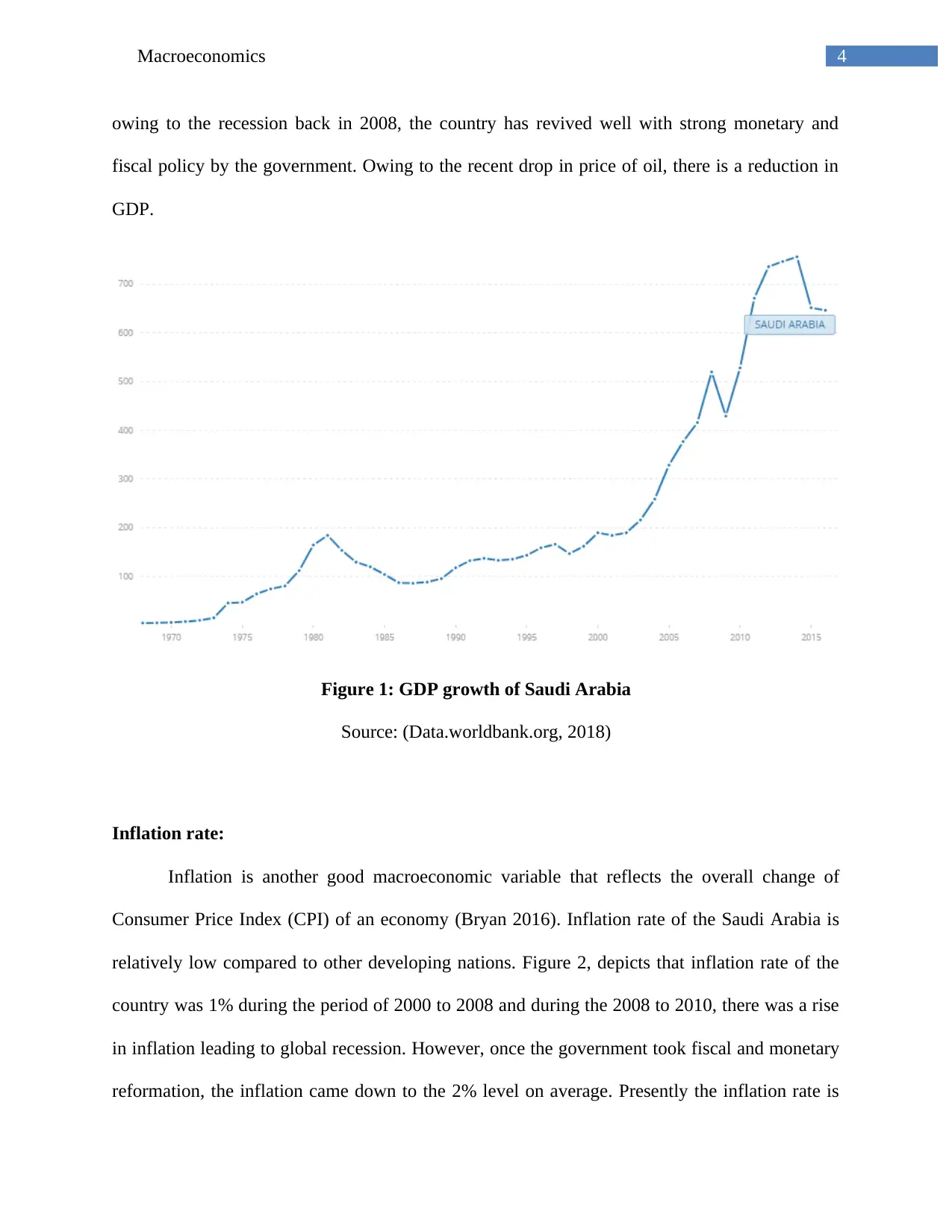
4Macroeconomics
owing to the recession back in 2008, the country has revived well with strong monetary and
fiscal policy by the government. Owing to the recent drop in price of oil, there is a reduction in
GDP.
Figure 1: GDP growth of Saudi Arabia
Source: (Data.worldbank.org, 2018)
Inflation rate:
Inflation is another good macroeconomic variable that reflects the overall change of
Consumer Price Index (CPI) of an economy (Bryan 2016). Inflation rate of the Saudi Arabia is
relatively low compared to other developing nations. Figure 2, depicts that inflation rate of the
country was 1% during the period of 2000 to 2008 and during the 2008 to 2010, there was a rise
in inflation leading to global recession. However, once the government took fiscal and monetary
reformation, the inflation came down to the 2% level on average. Presently the inflation rate is
owing to the recession back in 2008, the country has revived well with strong monetary and
fiscal policy by the government. Owing to the recent drop in price of oil, there is a reduction in
GDP.
Figure 1: GDP growth of Saudi Arabia
Source: (Data.worldbank.org, 2018)
Inflation rate:
Inflation is another good macroeconomic variable that reflects the overall change of
Consumer Price Index (CPI) of an economy (Bryan 2016). Inflation rate of the Saudi Arabia is
relatively low compared to other developing nations. Figure 2, depicts that inflation rate of the
country was 1% during the period of 2000 to 2008 and during the 2008 to 2010, there was a rise
in inflation leading to global recession. However, once the government took fiscal and monetary
reformation, the inflation came down to the 2% level on average. Presently the inflation rate is
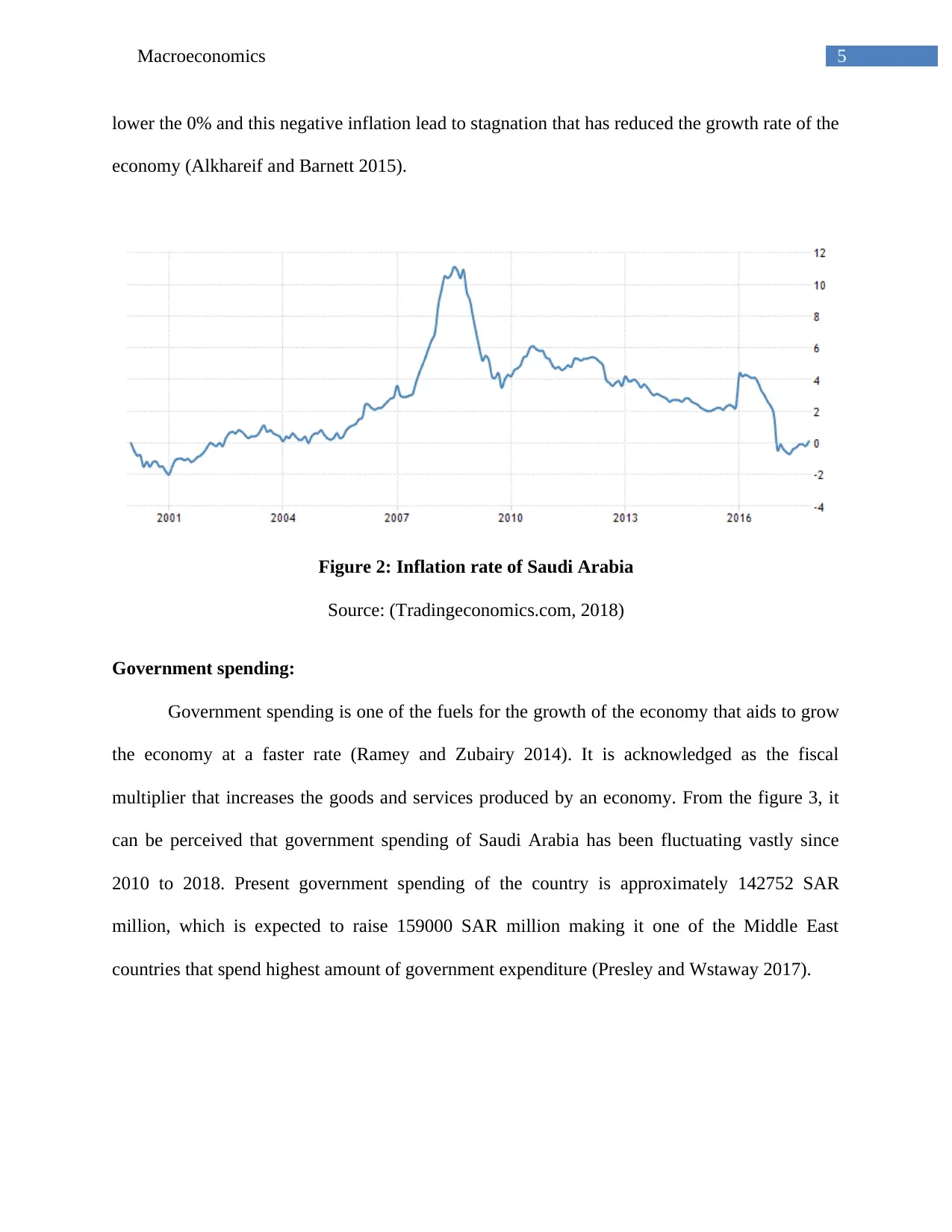
5Macroeconomics
lower the 0% and this negative inflation lead to stagnation that has reduced the growth rate of the
economy (Alkhareif and Barnett 2015).
Figure 2: Inflation rate of Saudi Arabia
Source: (Tradingeconomics.com, 2018)
Government spending:
Government spending is one of the fuels for the growth of the economy that aids to grow
the economy at a faster rate (Ramey and Zubairy 2014). It is acknowledged as the fiscal
multiplier that increases the goods and services produced by an economy. From the figure 3, it
can be perceived that government spending of Saudi Arabia has been fluctuating vastly since
2010 to 2018. Present government spending of the country is approximately 142752 SAR
million, which is expected to raise 159000 SAR million making it one of the Middle East
countries that spend highest amount of government expenditure (Presley and Wstaway 2017).
lower the 0% and this negative inflation lead to stagnation that has reduced the growth rate of the
economy (Alkhareif and Barnett 2015).
Figure 2: Inflation rate of Saudi Arabia
Source: (Tradingeconomics.com, 2018)
Government spending:
Government spending is one of the fuels for the growth of the economy that aids to grow
the economy at a faster rate (Ramey and Zubairy 2014). It is acknowledged as the fiscal
multiplier that increases the goods and services produced by an economy. From the figure 3, it
can be perceived that government spending of Saudi Arabia has been fluctuating vastly since
2010 to 2018. Present government spending of the country is approximately 142752 SAR
million, which is expected to raise 159000 SAR million making it one of the Middle East
countries that spend highest amount of government expenditure (Presley and Wstaway 2017).
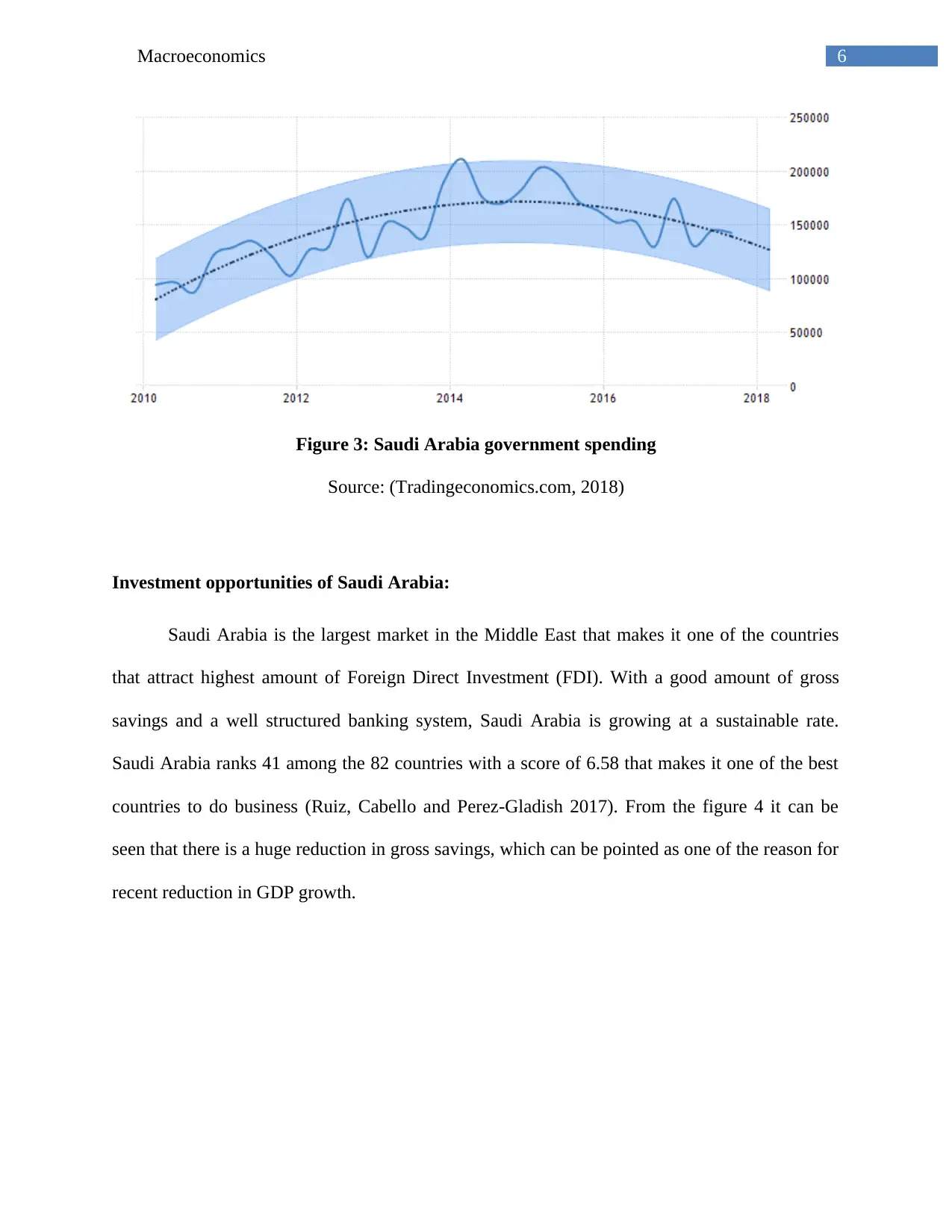
6Macroeconomics
Figure 3: Saudi Arabia government spending
Source: (Tradingeconomics.com, 2018)
Investment opportunities of Saudi Arabia:
Saudi Arabia is the largest market in the Middle East that makes it one of the countries
that attract highest amount of Foreign Direct Investment (FDI). With a good amount of gross
savings and a well structured banking system, Saudi Arabia is growing at a sustainable rate.
Saudi Arabia ranks 41 among the 82 countries with a score of 6.58 that makes it one of the best
countries to do business (Ruiz, Cabello and Perez-Gladish 2017). From the figure 4 it can be
seen that there is a huge reduction in gross savings, which can be pointed as one of the reason for
recent reduction in GDP growth.
Figure 3: Saudi Arabia government spending
Source: (Tradingeconomics.com, 2018)
Investment opportunities of Saudi Arabia:
Saudi Arabia is the largest market in the Middle East that makes it one of the countries
that attract highest amount of Foreign Direct Investment (FDI). With a good amount of gross
savings and a well structured banking system, Saudi Arabia is growing at a sustainable rate.
Saudi Arabia ranks 41 among the 82 countries with a score of 6.58 that makes it one of the best
countries to do business (Ruiz, Cabello and Perez-Gladish 2017). From the figure 4 it can be
seen that there is a huge reduction in gross savings, which can be pointed as one of the reason for
recent reduction in GDP growth.
Paraphrase This Document
Need a fresh take? Get an instant paraphrase of this document with our AI Paraphraser
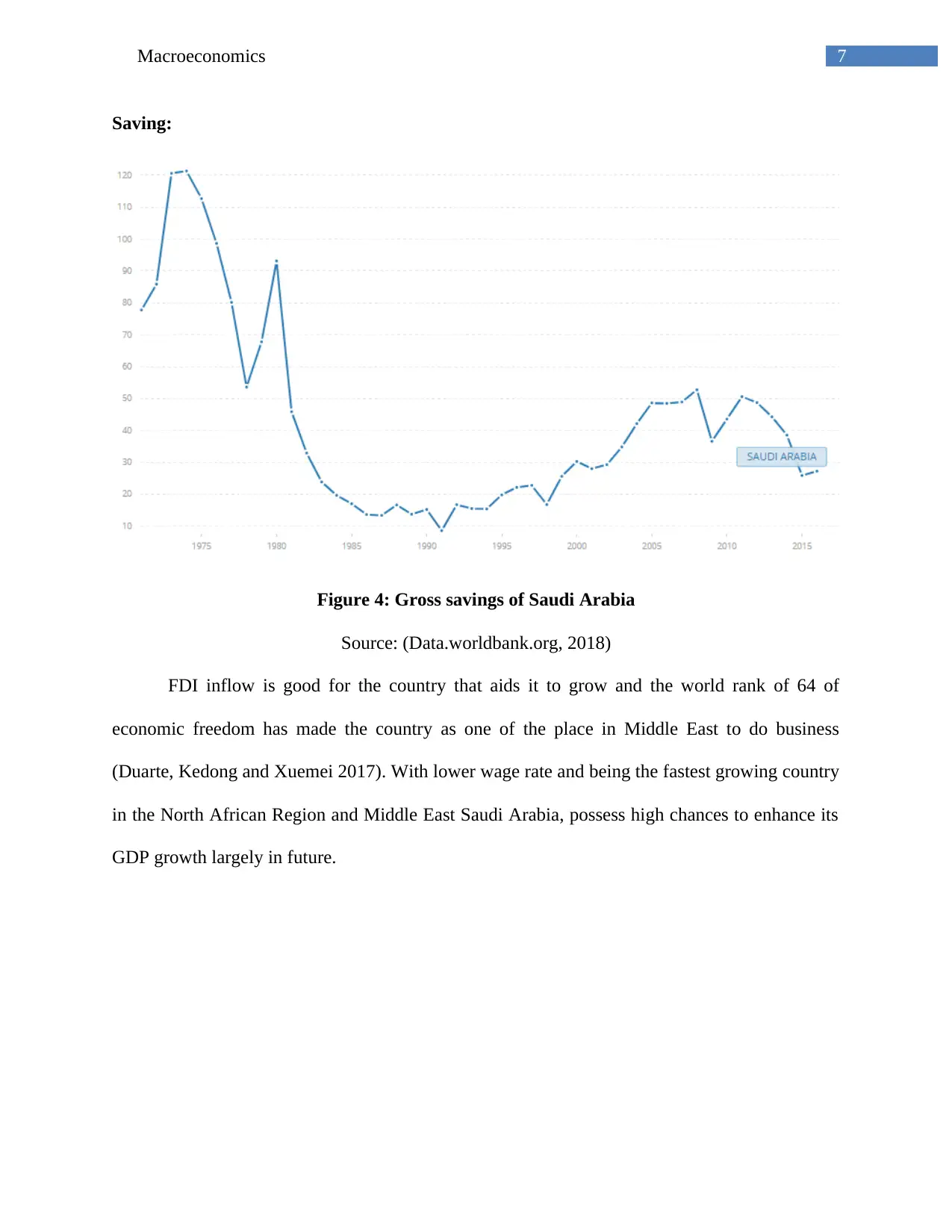
7Macroeconomics
Saving:
Figure 4: Gross savings of Saudi Arabia
Source: (Data.worldbank.org, 2018)
FDI inflow is good for the country that aids it to grow and the world rank of 64 of
economic freedom has made the country as one of the place in Middle East to do business
(Duarte, Kedong and Xuemei 2017). With lower wage rate and being the fastest growing country
in the North African Region and Middle East Saudi Arabia, possess high chances to enhance its
GDP growth largely in future.
Saving:
Figure 4: Gross savings of Saudi Arabia
Source: (Data.worldbank.org, 2018)
FDI inflow is good for the country that aids it to grow and the world rank of 64 of
economic freedom has made the country as one of the place in Middle East to do business
(Duarte, Kedong and Xuemei 2017). With lower wage rate and being the fastest growing country
in the North African Region and Middle East Saudi Arabia, possess high chances to enhance its
GDP growth largely in future.
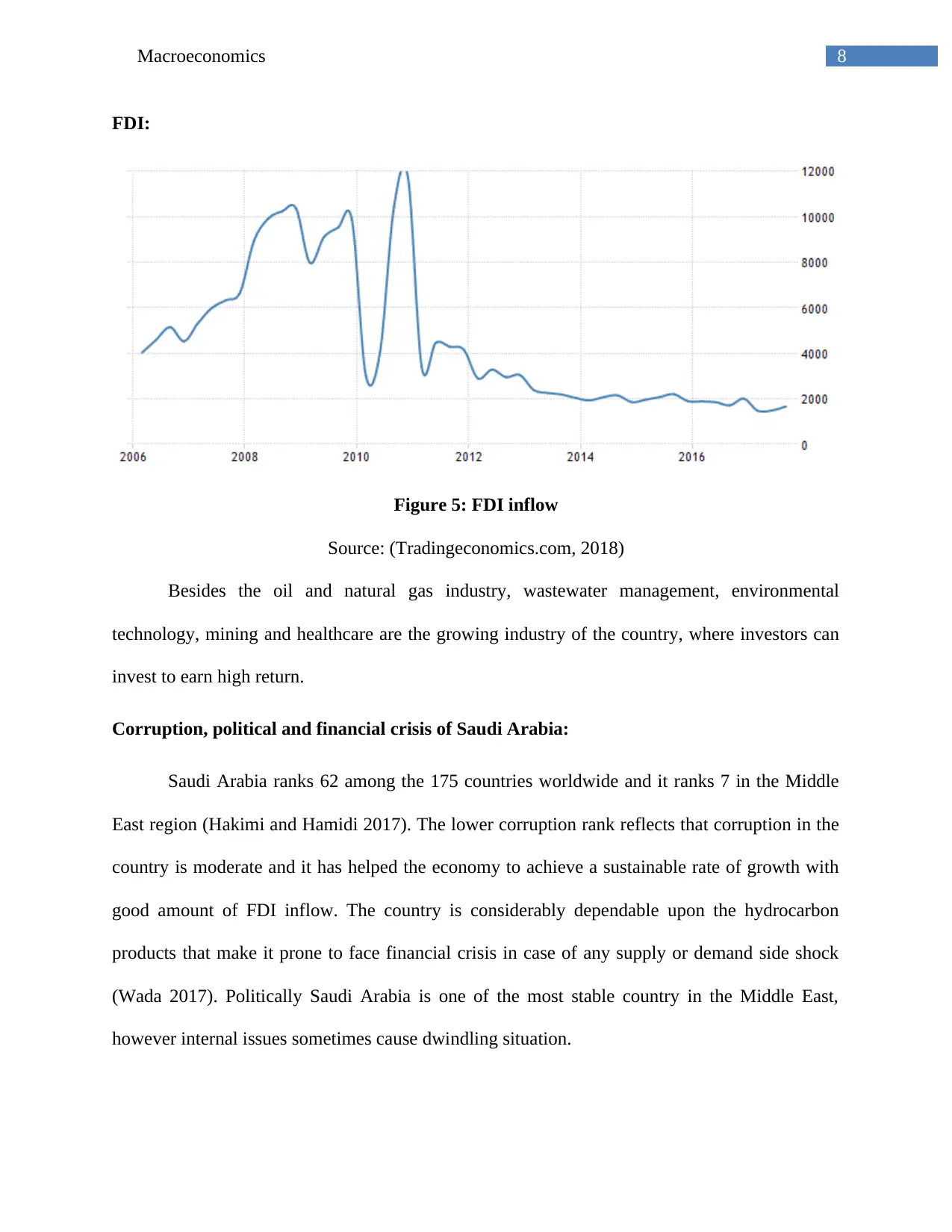
8Macroeconomics
FDI:
Figure 5: FDI inflow
Source: (Tradingeconomics.com, 2018)
Besides the oil and natural gas industry, wastewater management, environmental
technology, mining and healthcare are the growing industry of the country, where investors can
invest to earn high return.
Corruption, political and financial crisis of Saudi Arabia:
Saudi Arabia ranks 62 among the 175 countries worldwide and it ranks 7 in the Middle
East region (Hakimi and Hamidi 2017). The lower corruption rank reflects that corruption in the
country is moderate and it has helped the economy to achieve a sustainable rate of growth with
good amount of FDI inflow. The country is considerably dependable upon the hydrocarbon
products that make it prone to face financial crisis in case of any supply or demand side shock
(Wada 2017). Politically Saudi Arabia is one of the most stable country in the Middle East,
however internal issues sometimes cause dwindling situation.
FDI:
Figure 5: FDI inflow
Source: (Tradingeconomics.com, 2018)
Besides the oil and natural gas industry, wastewater management, environmental
technology, mining and healthcare are the growing industry of the country, where investors can
invest to earn high return.
Corruption, political and financial crisis of Saudi Arabia:
Saudi Arabia ranks 62 among the 175 countries worldwide and it ranks 7 in the Middle
East region (Hakimi and Hamidi 2017). The lower corruption rank reflects that corruption in the
country is moderate and it has helped the economy to achieve a sustainable rate of growth with
good amount of FDI inflow. The country is considerably dependable upon the hydrocarbon
products that make it prone to face financial crisis in case of any supply or demand side shock
(Wada 2017). Politically Saudi Arabia is one of the most stable country in the Middle East,
however internal issues sometimes cause dwindling situation.
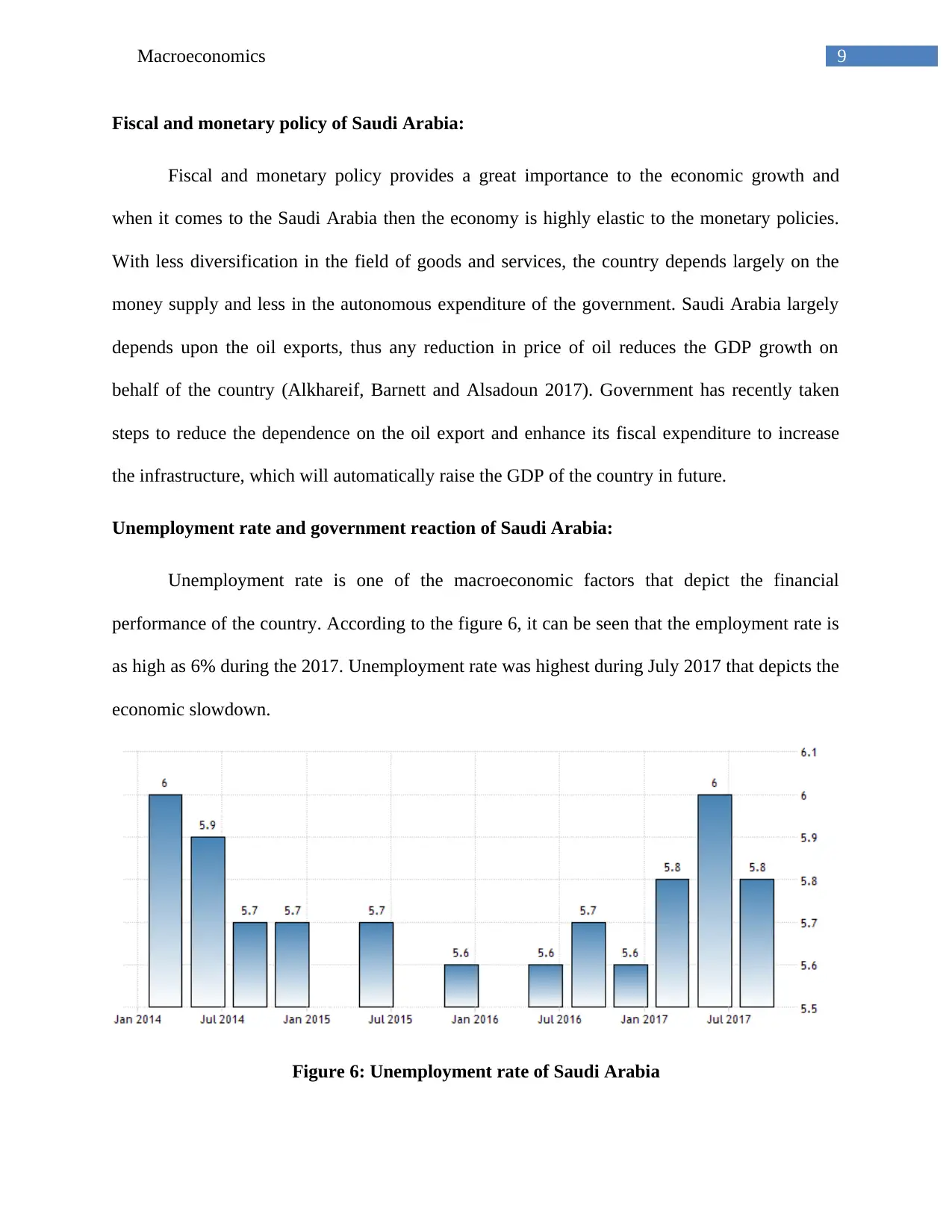
9Macroeconomics
Fiscal and monetary policy of Saudi Arabia:
Fiscal and monetary policy provides a great importance to the economic growth and
when it comes to the Saudi Arabia then the economy is highly elastic to the monetary policies.
With less diversification in the field of goods and services, the country depends largely on the
money supply and less in the autonomous expenditure of the government. Saudi Arabia largely
depends upon the oil exports, thus any reduction in price of oil reduces the GDP growth on
behalf of the country (Alkhareif, Barnett and Alsadoun 2017). Government has recently taken
steps to reduce the dependence on the oil export and enhance its fiscal expenditure to increase
the infrastructure, which will automatically raise the GDP of the country in future.
Unemployment rate and government reaction of Saudi Arabia:
Unemployment rate is one of the macroeconomic factors that depict the financial
performance of the country. According to the figure 6, it can be seen that the employment rate is
as high as 6% during the 2017. Unemployment rate was highest during July 2017 that depicts the
economic slowdown.
Figure 6: Unemployment rate of Saudi Arabia
Fiscal and monetary policy of Saudi Arabia:
Fiscal and monetary policy provides a great importance to the economic growth and
when it comes to the Saudi Arabia then the economy is highly elastic to the monetary policies.
With less diversification in the field of goods and services, the country depends largely on the
money supply and less in the autonomous expenditure of the government. Saudi Arabia largely
depends upon the oil exports, thus any reduction in price of oil reduces the GDP growth on
behalf of the country (Alkhareif, Barnett and Alsadoun 2017). Government has recently taken
steps to reduce the dependence on the oil export and enhance its fiscal expenditure to increase
the infrastructure, which will automatically raise the GDP of the country in future.
Unemployment rate and government reaction of Saudi Arabia:
Unemployment rate is one of the macroeconomic factors that depict the financial
performance of the country. According to the figure 6, it can be seen that the employment rate is
as high as 6% during the 2017. Unemployment rate was highest during July 2017 that depicts the
economic slowdown.
Figure 6: Unemployment rate of Saudi Arabia
Secure Best Marks with AI Grader
Need help grading? Try our AI Grader for instant feedback on your assignments.
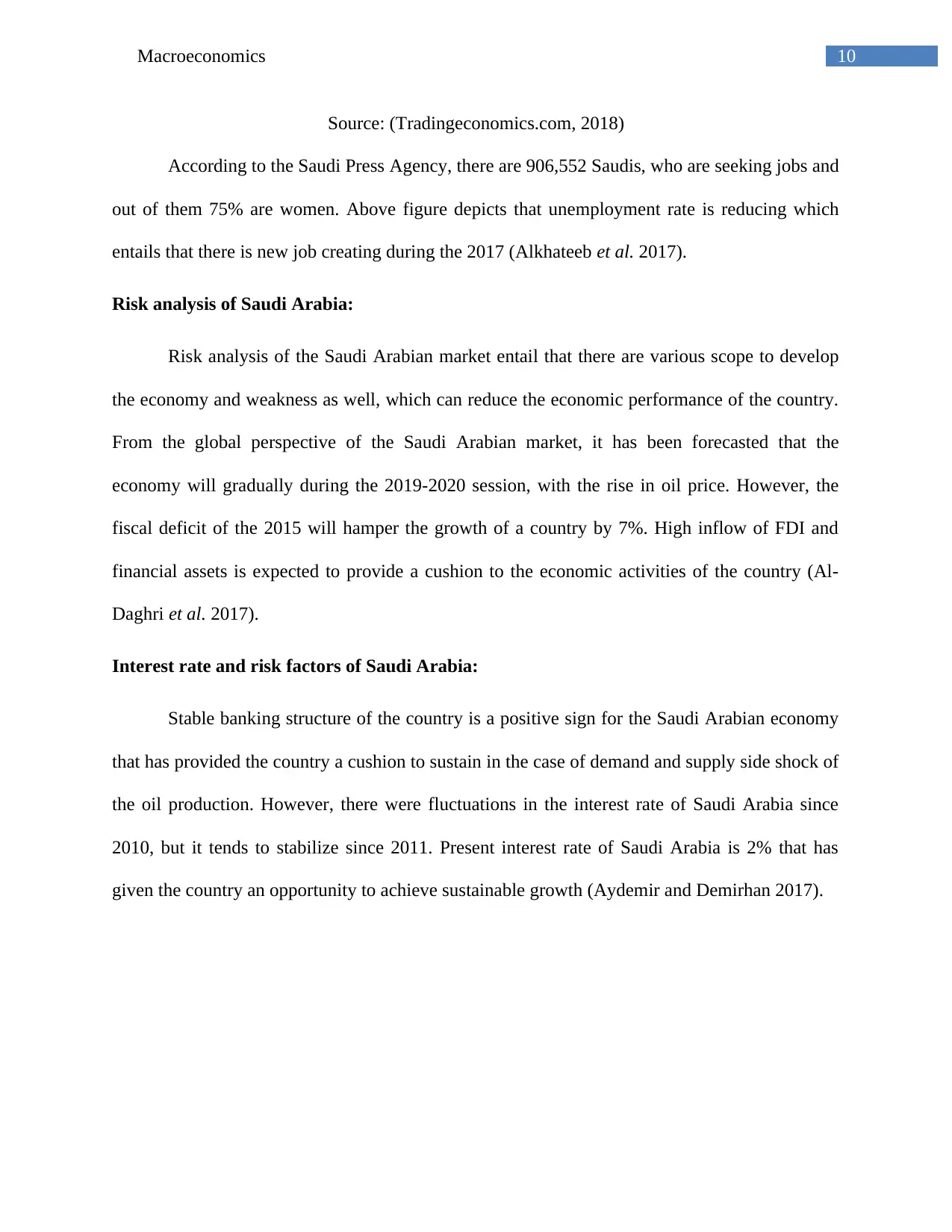
10Macroeconomics
Source: (Tradingeconomics.com, 2018)
According to the Saudi Press Agency, there are 906,552 Saudis, who are seeking jobs and
out of them 75% are women. Above figure depicts that unemployment rate is reducing which
entails that there is new job creating during the 2017 (Alkhateeb et al. 2017).
Risk analysis of Saudi Arabia:
Risk analysis of the Saudi Arabian market entail that there are various scope to develop
the economy and weakness as well, which can reduce the economic performance of the country.
From the global perspective of the Saudi Arabian market, it has been forecasted that the
economy will gradually during the 2019-2020 session, with the rise in oil price. However, the
fiscal deficit of the 2015 will hamper the growth of a country by 7%. High inflow of FDI and
financial assets is expected to provide a cushion to the economic activities of the country (Al-
Daghri et al. 2017).
Interest rate and risk factors of Saudi Arabia:
Stable banking structure of the country is a positive sign for the Saudi Arabian economy
that has provided the country a cushion to sustain in the case of demand and supply side shock of
the oil production. However, there were fluctuations in the interest rate of Saudi Arabia since
2010, but it tends to stabilize since 2011. Present interest rate of Saudi Arabia is 2% that has
given the country an opportunity to achieve sustainable growth (Aydemir and Demirhan 2017).
Source: (Tradingeconomics.com, 2018)
According to the Saudi Press Agency, there are 906,552 Saudis, who are seeking jobs and
out of them 75% are women. Above figure depicts that unemployment rate is reducing which
entails that there is new job creating during the 2017 (Alkhateeb et al. 2017).
Risk analysis of Saudi Arabia:
Risk analysis of the Saudi Arabian market entail that there are various scope to develop
the economy and weakness as well, which can reduce the economic performance of the country.
From the global perspective of the Saudi Arabian market, it has been forecasted that the
economy will gradually during the 2019-2020 session, with the rise in oil price. However, the
fiscal deficit of the 2015 will hamper the growth of a country by 7%. High inflow of FDI and
financial assets is expected to provide a cushion to the economic activities of the country (Al-
Daghri et al. 2017).
Interest rate and risk factors of Saudi Arabia:
Stable banking structure of the country is a positive sign for the Saudi Arabian economy
that has provided the country a cushion to sustain in the case of demand and supply side shock of
the oil production. However, there were fluctuations in the interest rate of Saudi Arabia since
2010, but it tends to stabilize since 2011. Present interest rate of Saudi Arabia is 2% that has
given the country an opportunity to achieve sustainable growth (Aydemir and Demirhan 2017).
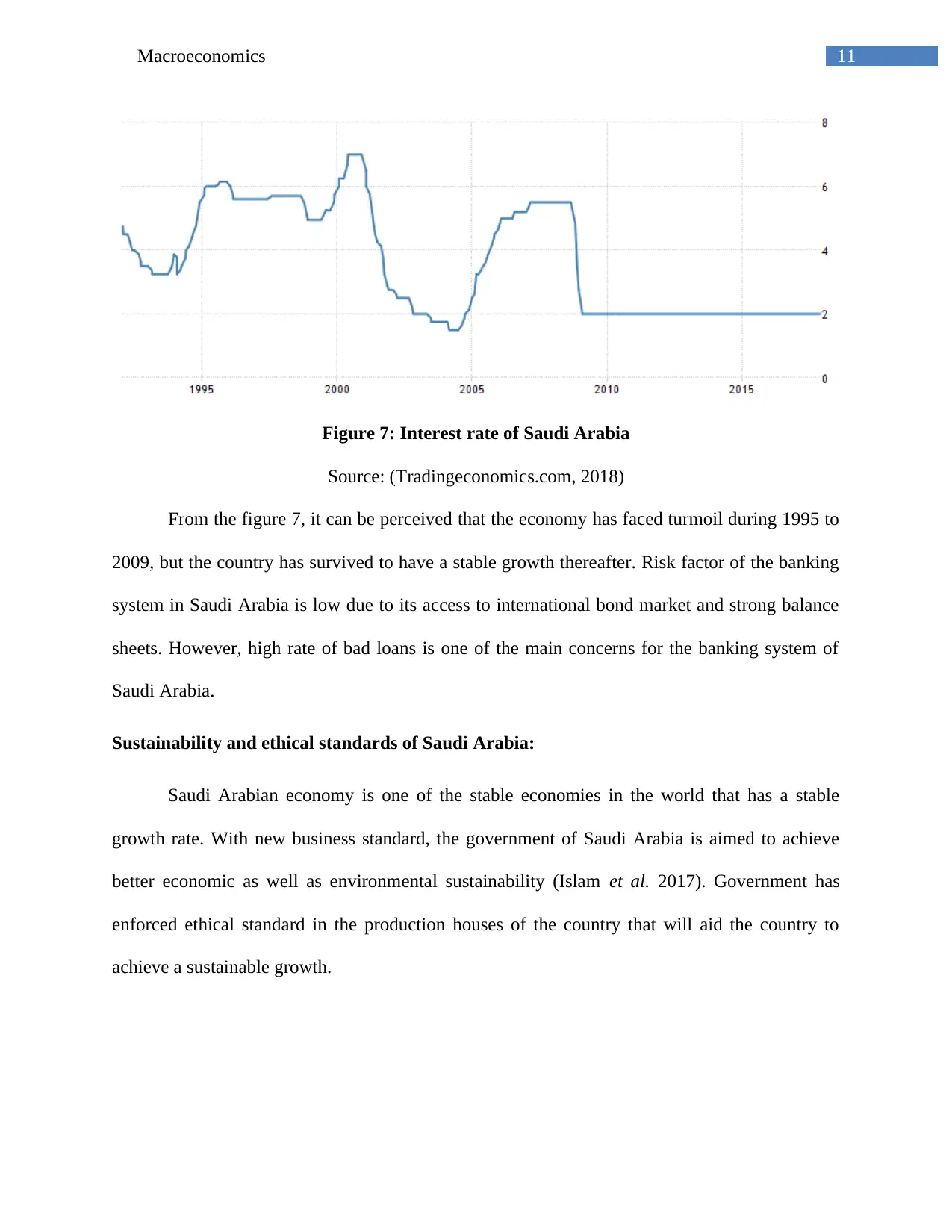
11Macroeconomics
Figure 7: Interest rate of Saudi Arabia
Source: (Tradingeconomics.com, 2018)
From the figure 7, it can be perceived that the economy has faced turmoil during 1995 to
2009, but the country has survived to have a stable growth thereafter. Risk factor of the banking
system in Saudi Arabia is low due to its access to international bond market and strong balance
sheets. However, high rate of bad loans is one of the main concerns for the banking system of
Saudi Arabia.
Sustainability and ethical standards of Saudi Arabia:
Saudi Arabian economy is one of the stable economies in the world that has a stable
growth rate. With new business standard, the government of Saudi Arabia is aimed to achieve
better economic as well as environmental sustainability (Islam et al. 2017). Government has
enforced ethical standard in the production houses of the country that will aid the country to
achieve a sustainable growth.
Figure 7: Interest rate of Saudi Arabia
Source: (Tradingeconomics.com, 2018)
From the figure 7, it can be perceived that the economy has faced turmoil during 1995 to
2009, but the country has survived to have a stable growth thereafter. Risk factor of the banking
system in Saudi Arabia is low due to its access to international bond market and strong balance
sheets. However, high rate of bad loans is one of the main concerns for the banking system of
Saudi Arabia.
Sustainability and ethical standards of Saudi Arabia:
Saudi Arabian economy is one of the stable economies in the world that has a stable
growth rate. With new business standard, the government of Saudi Arabia is aimed to achieve
better economic as well as environmental sustainability (Islam et al. 2017). Government has
enforced ethical standard in the production houses of the country that will aid the country to
achieve a sustainable growth.
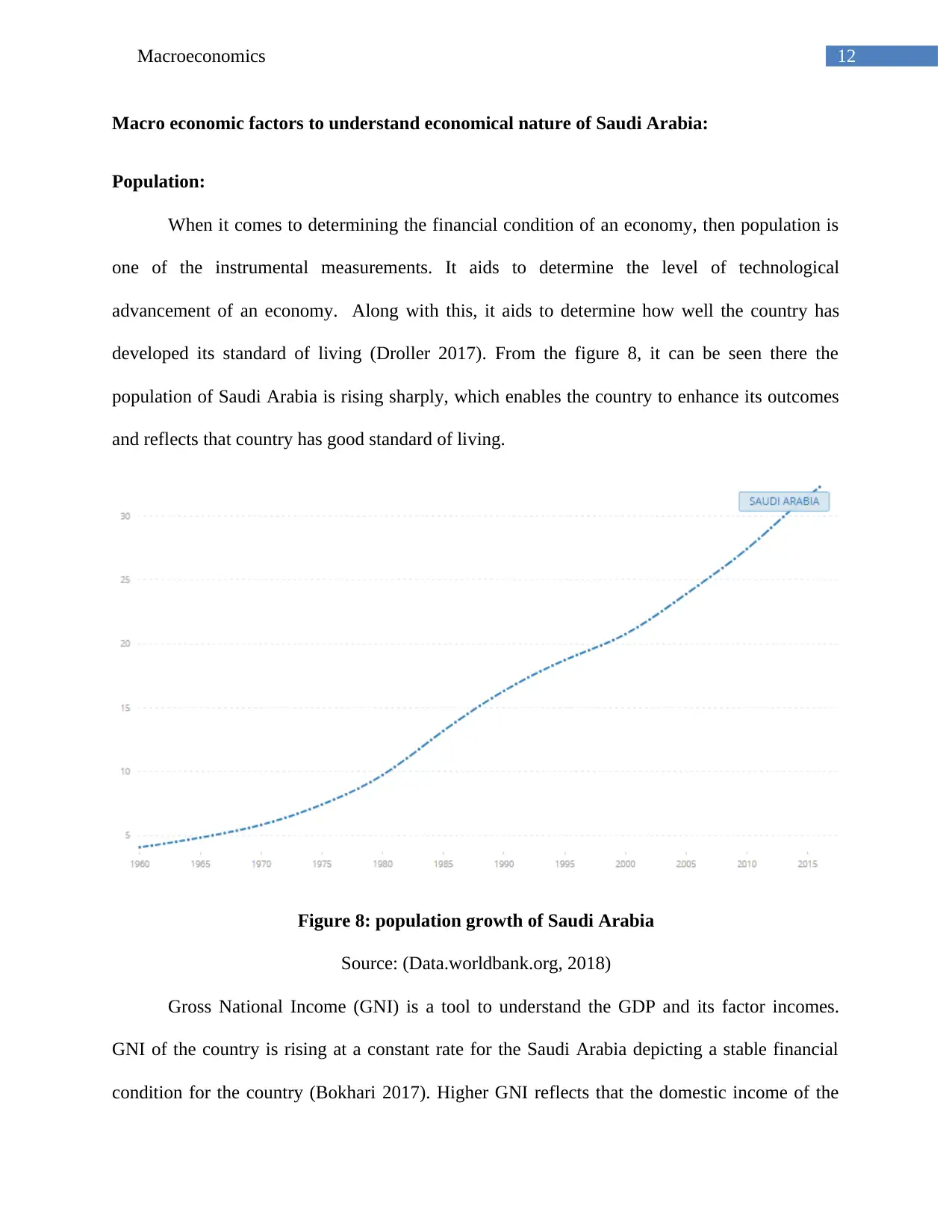
12Macroeconomics
Macro economic factors to understand economical nature of Saudi Arabia:
Population:
When it comes to determining the financial condition of an economy, then population is
one of the instrumental measurements. It aids to determine the level of technological
advancement of an economy. Along with this, it aids to determine how well the country has
developed its standard of living (Droller 2017). From the figure 8, it can be seen there the
population of Saudi Arabia is rising sharply, which enables the country to enhance its outcomes
and reflects that country has good standard of living.
Figure 8: population growth of Saudi Arabia
Source: (Data.worldbank.org, 2018)
Gross National Income (GNI) is a tool to understand the GDP and its factor incomes.
GNI of the country is rising at a constant rate for the Saudi Arabia depicting a stable financial
condition for the country (Bokhari 2017). Higher GNI reflects that the domestic income of the
Macro economic factors to understand economical nature of Saudi Arabia:
Population:
When it comes to determining the financial condition of an economy, then population is
one of the instrumental measurements. It aids to determine the level of technological
advancement of an economy. Along with this, it aids to determine how well the country has
developed its standard of living (Droller 2017). From the figure 8, it can be seen there the
population of Saudi Arabia is rising sharply, which enables the country to enhance its outcomes
and reflects that country has good standard of living.
Figure 8: population growth of Saudi Arabia
Source: (Data.worldbank.org, 2018)
Gross National Income (GNI) is a tool to understand the GDP and its factor incomes.
GNI of the country is rising at a constant rate for the Saudi Arabia depicting a stable financial
condition for the country (Bokhari 2017). Higher GNI reflects that the domestic income of the
Paraphrase This Document
Need a fresh take? Get an instant paraphrase of this document with our AI Paraphraser
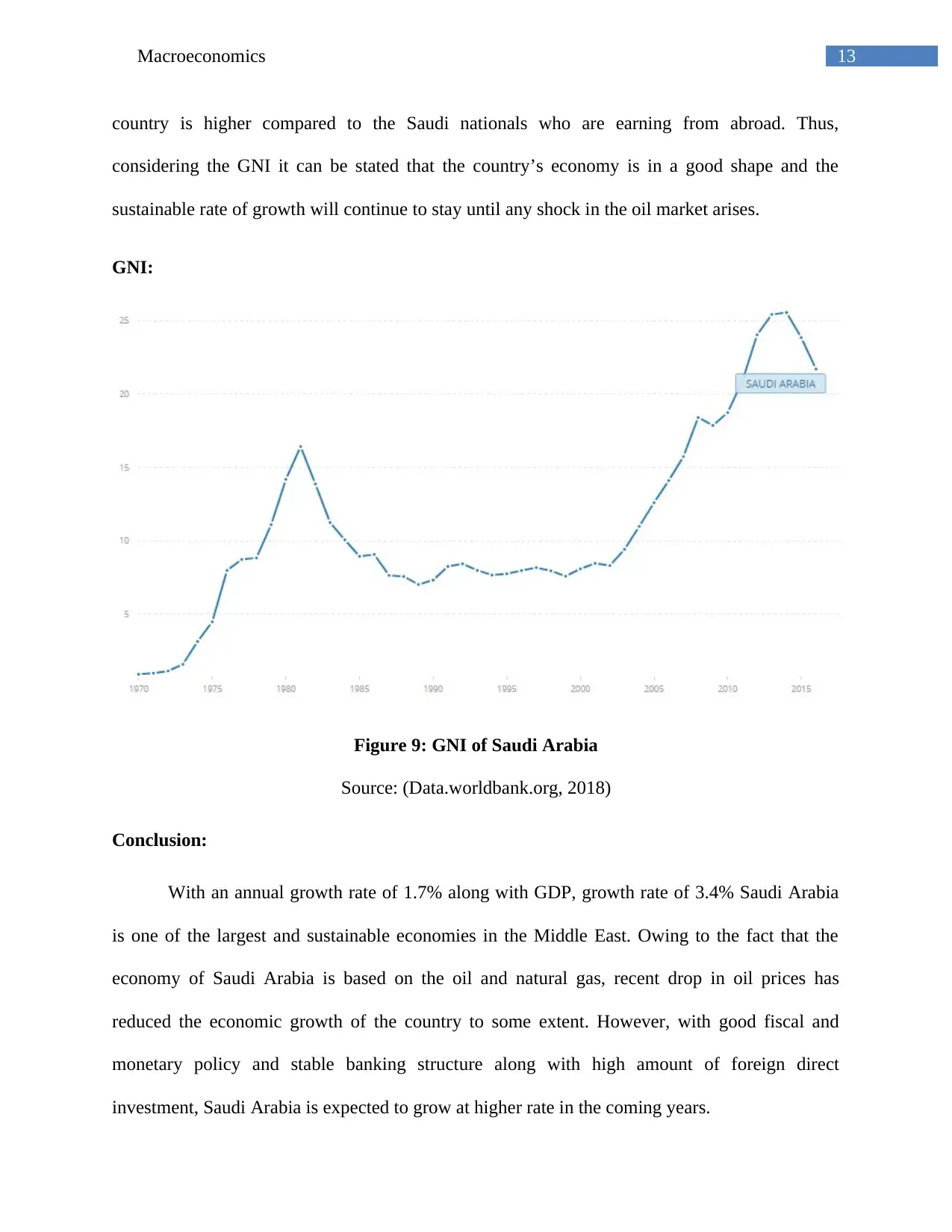
13Macroeconomics
country is higher compared to the Saudi nationals who are earning from abroad. Thus,
considering the GNI it can be stated that the country’s economy is in a good shape and the
sustainable rate of growth will continue to stay until any shock in the oil market arises.
GNI:
Figure 9: GNI of Saudi Arabia
Source: (Data.worldbank.org, 2018)
Conclusion:
With an annual growth rate of 1.7% along with GDP, growth rate of 3.4% Saudi Arabia
is one of the largest and sustainable economies in the Middle East. Owing to the fact that the
economy of Saudi Arabia is based on the oil and natural gas, recent drop in oil prices has
reduced the economic growth of the country to some extent. However, with good fiscal and
monetary policy and stable banking structure along with high amount of foreign direct
investment, Saudi Arabia is expected to grow at higher rate in the coming years.
country is higher compared to the Saudi nationals who are earning from abroad. Thus,
considering the GNI it can be stated that the country’s economy is in a good shape and the
sustainable rate of growth will continue to stay until any shock in the oil market arises.
GNI:
Figure 9: GNI of Saudi Arabia
Source: (Data.worldbank.org, 2018)
Conclusion:
With an annual growth rate of 1.7% along with GDP, growth rate of 3.4% Saudi Arabia
is one of the largest and sustainable economies in the Middle East. Owing to the fact that the
economy of Saudi Arabia is based on the oil and natural gas, recent drop in oil prices has
reduced the economic growth of the country to some extent. However, with good fiscal and
monetary policy and stable banking structure along with high amount of foreign direct
investment, Saudi Arabia is expected to grow at higher rate in the coming years.
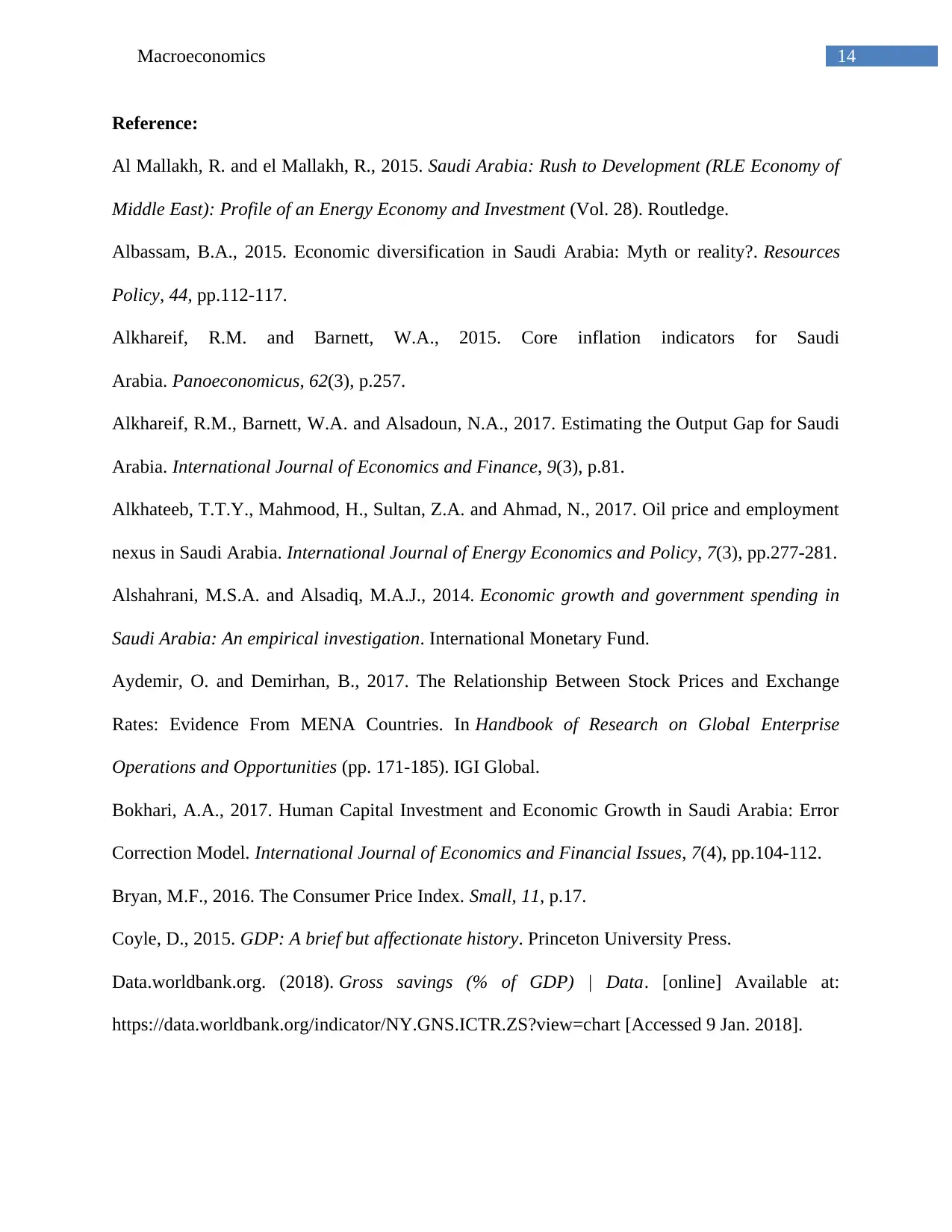
14Macroeconomics
Reference:
Al Mallakh, R. and el Mallakh, R., 2015. Saudi Arabia: Rush to Development (RLE Economy of
Middle East): Profile of an Energy Economy and Investment (Vol. 28). Routledge.
Albassam, B.A., 2015. Economic diversification in Saudi Arabia: Myth or reality?. Resources
Policy, 44, pp.112-117.
Alkhareif, R.M. and Barnett, W.A., 2015. Core inflation indicators for Saudi
Arabia. Panoeconomicus, 62(3), p.257.
Alkhareif, R.M., Barnett, W.A. and Alsadoun, N.A., 2017. Estimating the Output Gap for Saudi
Arabia. International Journal of Economics and Finance, 9(3), p.81.
Alkhateeb, T.T.Y., Mahmood, H., Sultan, Z.A. and Ahmad, N., 2017. Oil price and employment
nexus in Saudi Arabia. International Journal of Energy Economics and Policy, 7(3), pp.277-281.
Alshahrani, M.S.A. and Alsadiq, M.A.J., 2014. Economic growth and government spending in
Saudi Arabia: An empirical investigation. International Monetary Fund.
Aydemir, O. and Demirhan, B., 2017. The Relationship Between Stock Prices and Exchange
Rates: Evidence From MENA Countries. In Handbook of Research on Global Enterprise
Operations and Opportunities (pp. 171-185). IGI Global.
Bokhari, A.A., 2017. Human Capital Investment and Economic Growth in Saudi Arabia: Error
Correction Model. International Journal of Economics and Financial Issues, 7(4), pp.104-112.
Bryan, M.F., 2016. The Consumer Price Index. Small, 11, p.17.
Coyle, D., 2015. GDP: A brief but affectionate history. Princeton University Press.
Data.worldbank.org. (2018). Gross savings (% of GDP) | Data. [online] Available at:
https://data.worldbank.org/indicator/NY.GNS.ICTR.ZS?view=chart [Accessed 9 Jan. 2018].
Reference:
Al Mallakh, R. and el Mallakh, R., 2015. Saudi Arabia: Rush to Development (RLE Economy of
Middle East): Profile of an Energy Economy and Investment (Vol. 28). Routledge.
Albassam, B.A., 2015. Economic diversification in Saudi Arabia: Myth or reality?. Resources
Policy, 44, pp.112-117.
Alkhareif, R.M. and Barnett, W.A., 2015. Core inflation indicators for Saudi
Arabia. Panoeconomicus, 62(3), p.257.
Alkhareif, R.M., Barnett, W.A. and Alsadoun, N.A., 2017. Estimating the Output Gap for Saudi
Arabia. International Journal of Economics and Finance, 9(3), p.81.
Alkhateeb, T.T.Y., Mahmood, H., Sultan, Z.A. and Ahmad, N., 2017. Oil price and employment
nexus in Saudi Arabia. International Journal of Energy Economics and Policy, 7(3), pp.277-281.
Alshahrani, M.S.A. and Alsadiq, M.A.J., 2014. Economic growth and government spending in
Saudi Arabia: An empirical investigation. International Monetary Fund.
Aydemir, O. and Demirhan, B., 2017. The Relationship Between Stock Prices and Exchange
Rates: Evidence From MENA Countries. In Handbook of Research on Global Enterprise
Operations and Opportunities (pp. 171-185). IGI Global.
Bokhari, A.A., 2017. Human Capital Investment and Economic Growth in Saudi Arabia: Error
Correction Model. International Journal of Economics and Financial Issues, 7(4), pp.104-112.
Bryan, M.F., 2016. The Consumer Price Index. Small, 11, p.17.
Coyle, D., 2015. GDP: A brief but affectionate history. Princeton University Press.
Data.worldbank.org. (2018). Gross savings (% of GDP) | Data. [online] Available at:
https://data.worldbank.org/indicator/NY.GNS.ICTR.ZS?view=chart [Accessed 9 Jan. 2018].
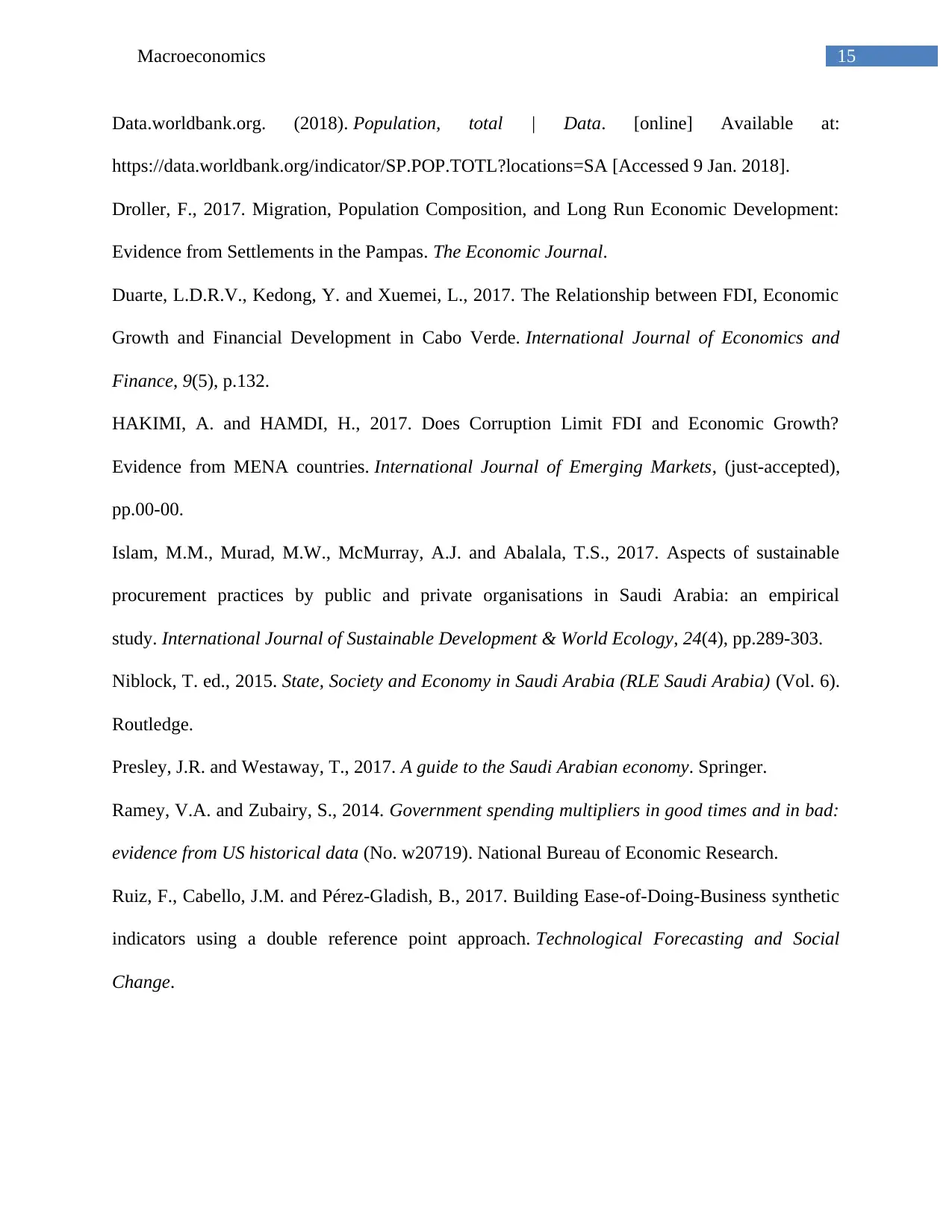
15Macroeconomics
Data.worldbank.org. (2018). Population, total | Data. [online] Available at:
https://data.worldbank.org/indicator/SP.POP.TOTL?locations=SA [Accessed 9 Jan. 2018].
Droller, F., 2017. Migration, Population Composition, and Long Run Economic Development:
Evidence from Settlements in the Pampas. The Economic Journal.
Duarte, L.D.R.V., Kedong, Y. and Xuemei, L., 2017. The Relationship between FDI, Economic
Growth and Financial Development in Cabo Verde. International Journal of Economics and
Finance, 9(5), p.132.
HAKIMI, A. and HAMDI, H., 2017. Does Corruption Limit FDI and Economic Growth?
Evidence from MENA countries. International Journal of Emerging Markets, (just-accepted),
pp.00-00.
Islam, M.M., Murad, M.W., McMurray, A.J. and Abalala, T.S., 2017. Aspects of sustainable
procurement practices by public and private organisations in Saudi Arabia: an empirical
study. International Journal of Sustainable Development & World Ecology, 24(4), pp.289-303.
Niblock, T. ed., 2015. State, Society and Economy in Saudi Arabia (RLE Saudi Arabia) (Vol. 6).
Routledge.
Presley, J.R. and Westaway, T., 2017. A guide to the Saudi Arabian economy. Springer.
Ramey, V.A. and Zubairy, S., 2014. Government spending multipliers in good times and in bad:
evidence from US historical data (No. w20719). National Bureau of Economic Research.
Ruiz, F., Cabello, J.M. and Pérez-Gladish, B., 2017. Building Ease-of-Doing-Business synthetic
indicators using a double reference point approach. Technological Forecasting and Social
Change.
Data.worldbank.org. (2018). Population, total | Data. [online] Available at:
https://data.worldbank.org/indicator/SP.POP.TOTL?locations=SA [Accessed 9 Jan. 2018].
Droller, F., 2017. Migration, Population Composition, and Long Run Economic Development:
Evidence from Settlements in the Pampas. The Economic Journal.
Duarte, L.D.R.V., Kedong, Y. and Xuemei, L., 2017. The Relationship between FDI, Economic
Growth and Financial Development in Cabo Verde. International Journal of Economics and
Finance, 9(5), p.132.
HAKIMI, A. and HAMDI, H., 2017. Does Corruption Limit FDI and Economic Growth?
Evidence from MENA countries. International Journal of Emerging Markets, (just-accepted),
pp.00-00.
Islam, M.M., Murad, M.W., McMurray, A.J. and Abalala, T.S., 2017. Aspects of sustainable
procurement practices by public and private organisations in Saudi Arabia: an empirical
study. International Journal of Sustainable Development & World Ecology, 24(4), pp.289-303.
Niblock, T. ed., 2015. State, Society and Economy in Saudi Arabia (RLE Saudi Arabia) (Vol. 6).
Routledge.
Presley, J.R. and Westaway, T., 2017. A guide to the Saudi Arabian economy. Springer.
Ramey, V.A. and Zubairy, S., 2014. Government spending multipliers in good times and in bad:
evidence from US historical data (No. w20719). National Bureau of Economic Research.
Ruiz, F., Cabello, J.M. and Pérez-Gladish, B., 2017. Building Ease-of-Doing-Business synthetic
indicators using a double reference point approach. Technological Forecasting and Social
Change.
Secure Best Marks with AI Grader
Need help grading? Try our AI Grader for instant feedback on your assignments.
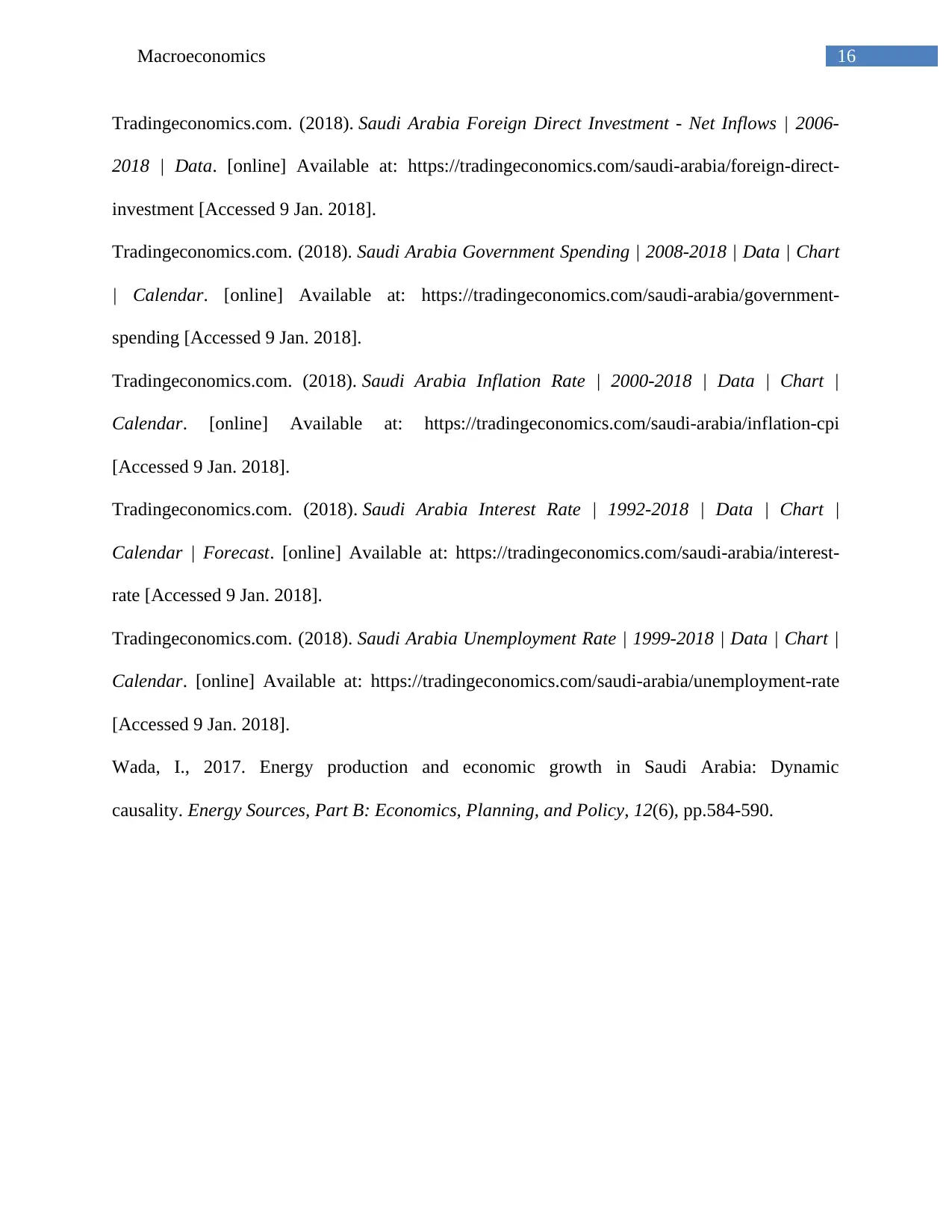
16Macroeconomics
Tradingeconomics.com. (2018). Saudi Arabia Foreign Direct Investment - Net Inflows | 2006-
2018 | Data. [online] Available at: https://tradingeconomics.com/saudi-arabia/foreign-direct-
investment [Accessed 9 Jan. 2018].
Tradingeconomics.com. (2018). Saudi Arabia Government Spending | 2008-2018 | Data | Chart
| Calendar. [online] Available at: https://tradingeconomics.com/saudi-arabia/government-
spending [Accessed 9 Jan. 2018].
Tradingeconomics.com. (2018). Saudi Arabia Inflation Rate | 2000-2018 | Data | Chart |
Calendar. [online] Available at: https://tradingeconomics.com/saudi-arabia/inflation-cpi
[Accessed 9 Jan. 2018].
Tradingeconomics.com. (2018). Saudi Arabia Interest Rate | 1992-2018 | Data | Chart |
Calendar | Forecast. [online] Available at: https://tradingeconomics.com/saudi-arabia/interest-
rate [Accessed 9 Jan. 2018].
Tradingeconomics.com. (2018). Saudi Arabia Unemployment Rate | 1999-2018 | Data | Chart |
Calendar. [online] Available at: https://tradingeconomics.com/saudi-arabia/unemployment-rate
[Accessed 9 Jan. 2018].
Wada, I., 2017. Energy production and economic growth in Saudi Arabia: Dynamic
causality. Energy Sources, Part B: Economics, Planning, and Policy, 12(6), pp.584-590.
Tradingeconomics.com. (2018). Saudi Arabia Foreign Direct Investment - Net Inflows | 2006-
2018 | Data. [online] Available at: https://tradingeconomics.com/saudi-arabia/foreign-direct-
investment [Accessed 9 Jan. 2018].
Tradingeconomics.com. (2018). Saudi Arabia Government Spending | 2008-2018 | Data | Chart
| Calendar. [online] Available at: https://tradingeconomics.com/saudi-arabia/government-
spending [Accessed 9 Jan. 2018].
Tradingeconomics.com. (2018). Saudi Arabia Inflation Rate | 2000-2018 | Data | Chart |
Calendar. [online] Available at: https://tradingeconomics.com/saudi-arabia/inflation-cpi
[Accessed 9 Jan. 2018].
Tradingeconomics.com. (2018). Saudi Arabia Interest Rate | 1992-2018 | Data | Chart |
Calendar | Forecast. [online] Available at: https://tradingeconomics.com/saudi-arabia/interest-
rate [Accessed 9 Jan. 2018].
Tradingeconomics.com. (2018). Saudi Arabia Unemployment Rate | 1999-2018 | Data | Chart |
Calendar. [online] Available at: https://tradingeconomics.com/saudi-arabia/unemployment-rate
[Accessed 9 Jan. 2018].
Wada, I., 2017. Energy production and economic growth in Saudi Arabia: Dynamic
causality. Energy Sources, Part B: Economics, Planning, and Policy, 12(6), pp.584-590.
1 out of 17
Related Documents
Your All-in-One AI-Powered Toolkit for Academic Success.
+13062052269
info@desklib.com
Available 24*7 on WhatsApp / Email
![[object Object]](/_next/static/media/star-bottom.7253800d.svg)
Unlock your academic potential
© 2024 | Zucol Services PVT LTD | All rights reserved.





